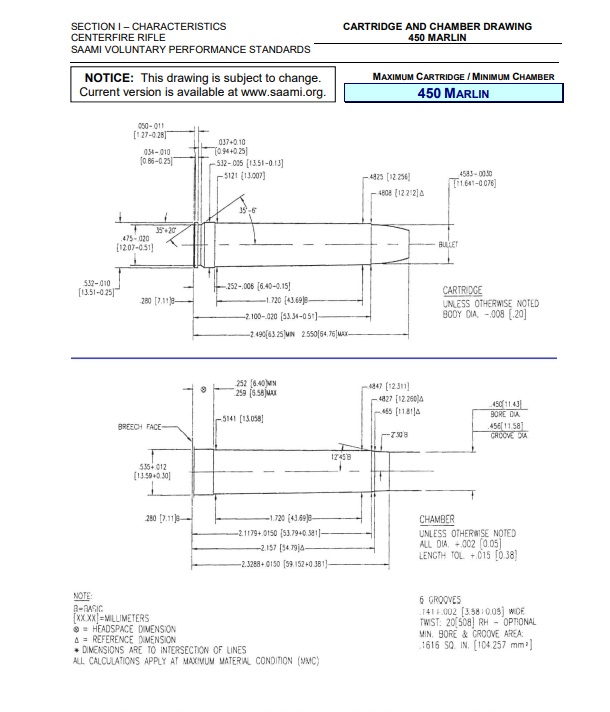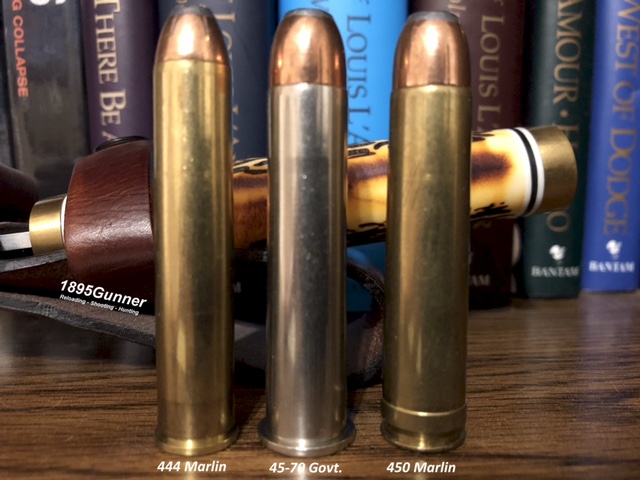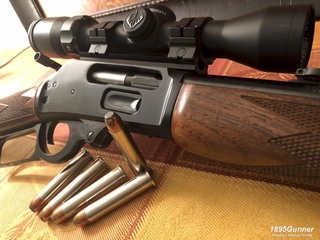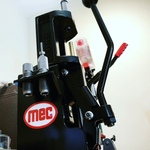 |
KNOWLEDGE CENTER1 8 9 5 G U N N E R.C O M
|
 |
KNOWLEDGE CENTER1 8 9 5 G U N N E R.C O M
|
Home > Knowledge Center > 450 Marlin450 MarlinHistoryThe Marlin new model .45-70, released in 1972 has without a doubt been a major success for Marlin. That being said, the full potential of this combination has only been possible through hand loading. This is due to the fact that factory produced .45-70 ammunition is loaded to low pressures and velocities for older firearms. In an effort to create a more powerful off the shelf combination for factory ammunition users, the companies Marlin and Hornady set about creating a new and more powerful factory cartridge.In 2000, Marlin and Hornady introduced the new .450 Marlin. The initial factory load featured the 350 grain Hornady Flat point Interlock at 2,100fps from the full length 24” barreled Marlin rifle, a significant boost in energy over the traditional .45-70 factory loads. While this combination could have been highly successful, the high cost of factory ammunition resulted in relatively poor market acceptance. As a hand loading proposition, the .450 Marlin had slightly less powder capacity than the .45-70 due to the heavy case walls so again, sales have been limited. Currently, the .450 Marlin enjoys limited popularity, mostly enjoyed by staunch fans of Marlin lever action rifles. Today Winchester is the only major supplier of firearms offering a rifle chambered for the .450 Marlin. Regardless of appeal, ultimately, it is very difficult to produce an affordable cartridge if it utilizes a large quantity of expensive raw materials as all big bore cartridges do.
PerformanceVarious authorities have criticized the .450 Marlin as having less power than .45-70 full capacity hand loads by 300fps and up to 500fps. In truth, these differences come about due to variations in rifle barrel length and porting rather than true case capacity. Case capacity of Hornady .450 brass is around 7 grains water less than Winchester .45-70 brass, a difference of 9%. While 9% more powder capacity should translate into 200fps higher velocity in favor of the .45-70, internal ballistics does not correlate in this wayThe .450 Marlin is a versatile short to medium range cartridge, ideal for light through to large medium game and adequate for large heavy game with due consideration. As a hand loader I typically load my .450’s the same as I do my .45-70’s. Same bullets, same powders & primers. Therefore there is no real advantage for one over the other with one exception and that is the cost and availability of .450 brass. Limited resources = higher pricing every day.
Factory ammunitionHornady produce two loads for the .450 Marlin, the lightest being the 325 grain FTX Leverevolution bullet at an advertised 2,225fps in 24” barrels giving on average 2,100fps in 24” barreled rifles and around 1,800fps in the stubby 18.5” barreled guide gun. This is purely a light to medium weight game bullet although several hunters have used it on relatively large game. The FTX bullet is incredibly devastating at very close ranges. But as velocity falls away, this bullet tends to be a mild performer and shows no advantage over traditional designs. The BC of the FTX bullet is no better than other .354 caliber flat nose projectiles and penetration must be regarded as poor at very close ranges with performance increasing as ranges are extended.Hornady’s heaviest load is the 350 grain flat point Interlock at a true 2,100fps in 24” barrels and 1,800fps in the guide gun. This Hornady bullet is a good all-around projectile for use on light through to large medium game. It is a fast killer and gives deep penetration along with a useful effective fast killing range. The 350 grain Interlock factory ammo is harder to find and works well on medium framed game such as deer and even elk or black bear. Unfortunately I don’t see any other factory ammo manufacturers taking on the .450 marlin.
Hand LoadingWith the high cost of factory ammunition, especially outside of the U.S, the .450 has become exactly what its makers had tried to avoid, a cartridge best utilized by hand loaders. These negative factors were mostly caused by the unforeseen rise in the cost of metals which occurred after the .450 was released. Put simply, without hand loading components, this cartridge would not survive-period.The .450 is very similar to the .45-70 regarding which powders are most effective. These include H-4198, IMR 4198 and ADI2207. One unique combination is H322 loaded behind heavy 400 grain projectiles and boasts velocities of 2,000fps, duplicating .45-70 full pressure, modern rifle loads. Aside from this, average achievable loads from 24” barrels include 2,300fps with 300 grain bullets, 2,100fps with 350 grain bullets and 1,900fps with 400 grain bullets. Like the .45-70, the .450 loses around 25fps per inch of barrel removed below 24”, in the 18.5” barreled Guide Gun this equates to a loss of around 137fps.
Final thoughtsWhile I indeed love this cartridge and have now owned three of the Marlin model 1895M, .450 Marlin Guide Guns I still cherish my Marlin Guide Guns in .45-70 more simply because I can afford to hand load them. The absolute best thing about the .450 Marlin is the smooth-as-silk cycling from the belted cases. If you haven’t chambered a round in the .450 you owe it to yourself to do so and decide for yourself, is this the gun for me?  |
| |
|
|
 |
 |
 |
 |
 |